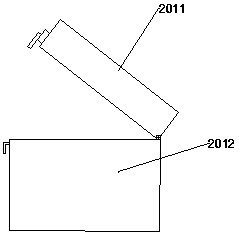Textile wastewater recycling method and device
A technology of textile wastewater and suspension device, applied in textile industry wastewater treatment, chemical instruments and methods, water/sewage multi-stage treatment, etc. and other problems, to achieve the effect of reducing the cost of wastewater treatment, expanding the scope of effective utilization, and improving the efficiency of wastewater treatment.
- Summary
- Abstract
- Description
- Claims
- Application Information
AI Technical Summary
Problems solved by technology
Method used
Image
Examples
Embodiment 1
[0040] A method for recycling textile waste water, comprising the steps of:
[0041] S1: Textile wastewater is pre-treated to obtain pre-treated water;
[0042] The pre-treatment includes sequential mechanical filtration and pre-treatment agent treatment and filtration; mechanical filtration adopts a grid;
[0043] S2: The pre-treated water is sent to the adjustment tank to adjust the pH to 4;
[0044] S3: enter the MBR reaction tank for treatment, and obtain water that meets the discharge standard.
[0045] The pretreatment agent comprises 30 parts of activated carbon, 20 parts of modified bagasse, 30 parts of adsorption polymer, 12 parts of bamboo powder with a particle diameter of 800-1000 microns, and 5 parts of acrylate.
[0046] The adsorption polymer is formed by using styrene and acrylate as monomers, adding divinylbenzene as a crosslinking agent, and toluene as a porogen.
[0047] The pretreatment agent is prepared by the following steps:
[0048] (1) Activated ca...
Embodiment 2
[0052] A method for recycling textile waste water, comprising the steps of:
[0053] S1: Textile wastewater is pre-treated to obtain pre-treated water;
[0054] The pre-treatment includes sequential mechanical filtration and pre-treatment agent treatment and filtration; mechanical filtration adopts a grid;
[0055] S2: The pre-treated water is sent to the adjustment tank to adjust the pH;
[0056] S3: enter the MBR reaction tank for treatment, and obtain water that meets the discharge standard.
[0057] The pretreatment agent includes 22 parts of activated carbon, 25 parts of modified bagasse, 20 parts of adsorption polymer, 20 parts of bamboo powder with a particle diameter of 800-1000 microns, and 8 parts of acrylate.
[0058] The adsorption polymer is formed by using styrene and acrylate as monomers, adding divinylbenzene as a crosslinking agent, and toluene as a porogen. Specific method: add acrylate monomer, styrene monomer, cross-linking agent and porogen to the aqueo...
Embodiment 3
[0065] A method for recycling textile waste water, comprising the steps of:
[0066] S1: Textile wastewater is pre-treated to obtain pre-treated water;
[0067] The pre-treatment includes sequential mechanical filtration and pre-treatment agent treatment and filtration; mechanical filtration adopts a grid;
[0068] S2: The pre-treated water is sent to the adjustment tank to adjust the pH;
[0069] S3: enter the MBR reaction tank for treatment, and obtain water that meets the discharge standard.
[0070] The pretreatment agent includes 25 parts of activated carbon, 25 parts of modified bagasse, 25 parts of adsorption polymer, 18 parts of bamboo powder with a particle diameter of 800-900 microns, and 3 parts of acrylate.
[0071] The adsorption polymer is formed by using styrene and acrylate as monomers, adding divinylbenzene as a crosslinking agent, and toluene as a porogen.
[0072] The pretreatment agent is prepared by the following steps:
[0073] (1) Activated carbon is...
PUM
| Property | Measurement | Unit |
|---|---|---|
| particle size (mesh) | aaaaa | aaaaa |
| particle diameter | aaaaa | aaaaa |
| particle diameter | aaaaa | aaaaa |
Abstract
Description
Claims
Application Information
 Login to View More
Login to View More - R&D Engineer
- R&D Manager
- IP Professional
- Industry Leading Data Capabilities
- Powerful AI technology
- Patent DNA Extraction
Browse by: Latest US Patents, China's latest patents, Technical Efficacy Thesaurus, Application Domain, Technology Topic, Popular Technical Reports.
© 2024 PatSnap. All rights reserved.Legal|Privacy policy|Modern Slavery Act Transparency Statement|Sitemap|About US| Contact US: help@patsnap.com










